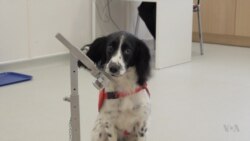ໝາເປັນສັດຈຳພວກທີ່ຄົນເຮົາຮູ້ຈັກກັນດີ ແລະ ມີຄຸນສົມບັດ ວ່າມີຄວາມສາມາດຂອງ
ພວກມັນໃນການດົມຫາກິ່ນໄດ້ທຸກຢ່າງ ເຊັ່ນ ຢາເສບຕິດ, ຫາລະເບີດ ເຖິງວັດຖຸອີເລັກ
ໂທຣນິກເຖື່ອນ. ແຕ່ບັນດານັກວິທະຍາສາດໃນມະຫາວິທະຍາໄລ ແລງແຄສເຕີ ໄດ້
ຊ້ອມໃຫ້ມັນສືບຫາກິ່ນຂອງຄວາມເຈັບປ່ວຍ, ໂດຍສະເພາະແມ່ນໂຣກ ມາເລເຣຍ ຫຼື
ໂຣກໄຂ້ຍຸງ. ແລະ ນັ້ນອາດເປັນການປ່ຽນແປງໃໝ່ ໃນການຕໍ່ສູ້ ເພື່ອຢຸດການແຜ່ລະ
ບາດຂອງໂຣກດັ່ງກ່າວ. ນັກຂ່າວວີໂອເອ ເຄວິນ ອີນັອກສ໌ ມີລາຍງານ, ເຊິ່ງ ພຸດທະ
ສອນ ຈະນຳລາຍລະອຽດມາສະເໜີທ່ານໃນອັນດັບຕໍ່ໄປ.
ນີ້ແມ່ນວິທີທີ່ການສຶກສາດັ່ງກ່າວເຮັດວຽກ. ພວກນັກຮຽນໃນປະເທດ ການາ ບາງຄົນ
ທັງຜູ້ທີ່ເປັນໂຣກມາເລເຣຍ ແລະຜູ້ບໍ່ເປັນບາງຄົນ ຕ່າງກໍໄດ້ຮັບເອົາຖົງຕີນໄປໃສ່ຜູ້
ລະນຶ່ງຄືນ.
ແລະ ໝາທີ່ຖືກຝຶກ ຈະພະຍາຍາມລະບຸຖົງຕີນທີ່ມີຫຼັກຖານວ່າ ແມ່ນເຊື້ອ ມາເລເຣຍ
ນັ້ນ.
ທ່ານ ສຕີຟ ລິນເຊ ຈາກມະຫາວິທະຍາໄລ ເດີແຮັມ ກ່າວວ່າ “ມັນມີຫຼັກຖານທີ່ຄົນທີ່ມີ
ເຊື້ອມາເລເຣຍ ຈະມີກິ່ນສະເພາະຂອງມັນ. ເຂົາເຈົ້າຈະມີກິ່ນແຕກຕ່າງຈາກຜູ້ອື່ນ,
ແລະ ຍິ່ງສຳຄັນກວ່ານັ້ນ ໂຕຍຸງຈະເລືອກກິນເລືອດຂອງຜູ້ທີ່ມີເຊື້ອມາເລເຣຍຢູ່ແລ້ວ.
ສະນັ້ນ ຖ້າຍຸງສາມາດເຮັດແນວນັ້ນໄດ້ ເປັນຫຍັງພວກໝາຈຶ່ງຈະເຮັດບໍ່ໄດ້?
ໝາຄືໂຕທີ່ຊື່ວ່າ ເຟຣຢາ ແມ່ນໄດ້ຖືກຝຶກຝົນມາ ໂດຍກຸ່ມໝາກວດກາດ້ານການແພດ
ແມ່ນສາມາດທີ່ຈະລະບຸເຊື້ອມາເລເຣຍໄດ້ ຢ່າງແນ່ນອນເຖິງ 70 ເປີເຊັນໃນແຕ່ລະຄັ້ງ.
ແລະ ທ່ານ ລິນເຊ ເວົ້າວ່າ ສິ່ງນີ້ ອາດນຳໄປສູ່ວິທີໃໝ່ ແລະ ມີປະສິດທິພາບແທ້ໆ
ກ່ຽວກັບ ການຢຸດ ບໍ່ໃຫ້ໂຣກມາເລເຣຍແຜ່ລະບາດ.
ທ່ານ ສຕີຟ ລິນເຊ ກ່າວວ່າ “ຖ້າເຈົ້າໄດ້ຫຍັບເຂົ້າໃກ້ການລົບລ້າງໄຂ້ມາເລເຣຍແທ້ໆ
ແລະ ເຈົ້າກຳລັງພະຍາຍາມຫາຈຸດສູນກາງພວກນັ້ນ ແລະ ຜູ້ທີ່ຕິດເຊື້ອ, ແທນທີ່ຈະ
ໄປກວດຫາທຸກຄົນ. ໝາແມ່ນອາດຈະດີພໍ ທີ່ຈະຍ່າງໄປຫາບ້ານຕ່າງໆ ແລະ ຊອກຫາ
ຄົນທີ່ຕິດເຊື້ອນັ້ນ.”
ທ່ານ ລິນເຊ ເວົ້າວ່າ ໝາແມ່ນໄດ້ຢູ່ໃນແຖວໜ້າຂອງການກວດຫາເຊື້ອໂຣກ ແລະ
ຂອງເຖື່ອນແລ້ວ, ແຕ່ກໍອາດຈະສາມາດກວດຫາທີ່ມາຂອງຄວາມເຈັບປ່ວຍອື່ນໆໄດ້
ເຊັ່ນກັນ.
ທ່ານ ສຕີຟ ລິນເຊ ກ່າວວ່າ “ສະນັ້ນຄົນຜູ້ທີ່ຂ້າພະເຈົ້າເຮັດວຽກຮ່ວມນຳ, ຜູ້ຝຶກສອນ
ໝາ, ໄດ້ເຮັດວຽກກັບໝາຂອງເຂົາເຈົ້າເພື່ອກວດຫາໂຣກມະເຮັງ ແລະ ໂຣກມືສັ່ນ
ພາກິນສັນ ແລະ ແທ້ຈິງແລ້ວ ເຂົາເຈົ້າໄດ້ເຕືອນໝາທີ່ເຮັດວຽກກັບຄົນເປັນເບົາຫວານ
ວ່າ ເວລາທີ່ເຂົາເຈົ້າຈະມີພາວະນ້ຳຕານໃນເລືອດຕ່ຳ ໂຕໝາຈະແຈ້ງໃຫ້ຄົນຜູ້ນັ້ນຮູ້,
ເຕືອນໃຫ້ຮູ້.”
ກຸ່ມນັກກວດກາສຸຂະພາບ ຍັງໄດ້ເຮັດວຽກກັບ ສະຖາບັນເທັກໂນໂລຈີ ລັດ
ແມັສຊາຈູເຊັດສ໌ ຫຼື MIT ເພື່ອສ້າງດັງອີເລັກໂທນິກ ຫຼື E-nose ທີ່ສາມາດເຮັດສິ່ງ
ຕ່າງໆຄືໂຕໝາເຮັດ, ແຕ່ທ່ານເວົ້າວ່າ ດັງຂອງໝາແມ່ນອ່ອນໄຫວແລະຮູ້ສຶກໄດ້ດີຫຼາຍ
ເຊິ່ງເທັກໂນໂລຈີແມ່ນຍັງບໍ່ມີເທື່ອ ທີ່ຈະທຽບເທົ່າກັບພະລັງການດົມກິ່ນສືບກິ່ນແບບ
ໝາໄດ້ເທື່ອ.
Dogs are well known and valued for their ability to smell everything from drugs, to bombs to contraband electronics. But scientists at Lancaster University have trained them to sniff out illnesses, specifically Malaria. And that could be game changing in the fight to stop the spread of the disease. VOA's Kevin Enochs reports.
Here's how the study worked.Children in Ghana - some of whom had malaria some who did not - were given socks to wear for one night.
And the trained dogs tried to identify the socks that had evidence of the malarial parasite.
"There's accumulating evidence that people that have malaria parasites have specific odors. They smell differently from other people, and more importantly mosquitos preferentially feed on people with malaria. So if mosquitos can do it why not dogs?"
Dogs like Freya trained by the group Medical Detection dogs were able to identify malaria correctly 70 percent of the time.
And Lindsay says this could lead to new and really effective ways of stopping Malaria from spreading.
"...if that you're getting really close to malaria elimination and you're trying to find those hot spots and who is infected, rather than screening everyone the dogs might be good enough to go into villages and find people."
Lindsay says dogs are already on the front lines of disease and contraband detection, but may be able to detect a host of other illnesses as well.
"So the folks that I'm working with, the dog handlers, have worked with their dogs to detect cancers and Parkinson's Disease and they actually have alert dogs that work with diabetic patients that when they are going into hypoglycemia the dogs notify the person, alert the person."
The Medical Detection Team is also working with MIT to create a kind of E-nose that could do what the dogs do, but he says the dogs noses are so sensitive the technology doesn't yet exist to match their sniffing power.





